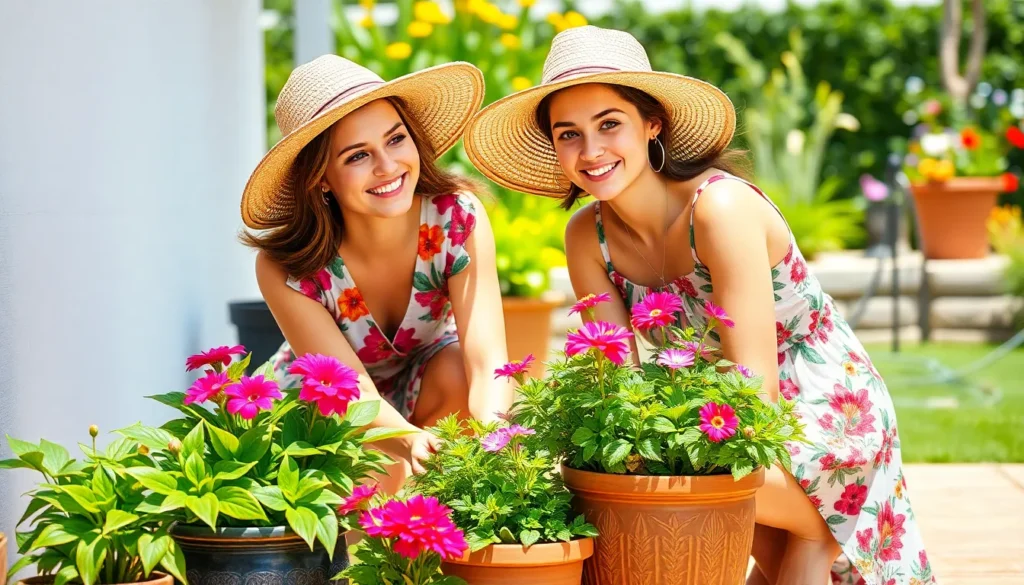We’ve all dreamed of having that perfect outdoor space – one that’s both stunning and manageable. Landscaping with potted plants offers the ideal solution for creating beautiful gardens without the commitment of permanent installations. Whether you’re working with a small patio, rental property, or simply want flexibility in your design, container gardening transforms any space into a lush oasis.
Potted plants give us the power to experiment with layouts, move seasonal displays, and even take our favorite plants with us when we relocate. From dramatic statement pieces to charming clusters of herbs and flowers, containers let us create personalized landscapes that reflect our style and adapt to our lifestyle.
The best part? We don’t need acres of land or perfect soil conditions to create magazine-worthy outdoor spaces. With the right techniques and plant choices, we can design stunning landscapes that thrive in containers while maximizing both beauty and functionality.
Choose the Right Containers for Your Outdoor Space
Selecting appropriate containers forms the foundation of successful potted plant landscaping. We’ll guide you through the essential factors that transform ordinary planters into stunning focal points for your outdoor design.
Consider Size and Scale for Visual Impact
Large containers create bold statements while providing ample root space for substantial plant growth. We recommend using pots that measure at least 18-24 inches in diameter for single specimen plants like small trees or large shrubs. These oversized planters anchor your industry design and prevent the “toy garden” appearance that smaller containers often create.
Medium sized planters work perfectly for grouping multiple plants together in attractive arrangements. Containers measuring 12-16 inches across accommodate combinations of trailing plants, upright specimens, and filler varieties. We’ve found that odd numbered groupings of three or five medium pots create more natural looking displays than even numbers.
Small accent containers add finishing touches to your overall design scheme without overwhelming the space. Pots ranging from 6-10 inches work best for herbs, succulents, or seasonal color displays. These petite planters shine when clustered on steps, tabletops, or integrated into larger container groupings.
Select Weather-Resistant Materials
Terra cotta containers offer classic appeal but require protection in freezing climates where moisture can cause cracking. We suggest bringing these traditional clay pots indoors during winter months or choosing glazed versions that resist moisture absorption better than unglazed alternatives.
Fiberglass planters deliver exceptional durability while maintaining an attractive appearance that mimics stone, ceramic, or wood textures. These lightweight options resist fading, cracking, and temperature extremes while remaining easy to move when rearranging your outdoor space.
Concrete and stone containers provide permanent fixtures that anchor your industry design through all seasons. We recommend these heavy duty materials for large plantings or areas where you want containers to remain stationary year round.
Resin and plastic options offer budget friendly answers with impressive weather resistance and unlimited color choices. Modern manufacturing techniques create realistic textures that closely resemble natural materials while weighing significantly less than traditional alternatives.
Ensure Proper Drainage Systems
Drainage holes prevent root rot by allowing excess water to escape rather than pooling around plant roots. We insist on containers with multiple holes measuring at least half an inch in diameter, positioned around the bottom perimeter rather than just in the center.
Drainage layers improve water flow through heavy potting mixtures that might otherwise become waterlogged. Place two inches of gravel, broken pottery, or commercial drainage stones in the bottom before adding soil to create space for water movement.
Elevated positioning enhances drainage effectiveness by lifting containers slightly off ground surfaces where water might otherwise collect. We use pot feet, bricks, or wooden blocks to create air circulation underneath planters while protecting deck and patio surfaces from water stains.
Saucers protect surfaces but require regular emptying to prevent standing water problems. Remove accumulated water within 30 minutes after watering to maintain healthy root conditions while preserving your outdoor flooring materials.
Select Plants That Thrive in Container Gardens
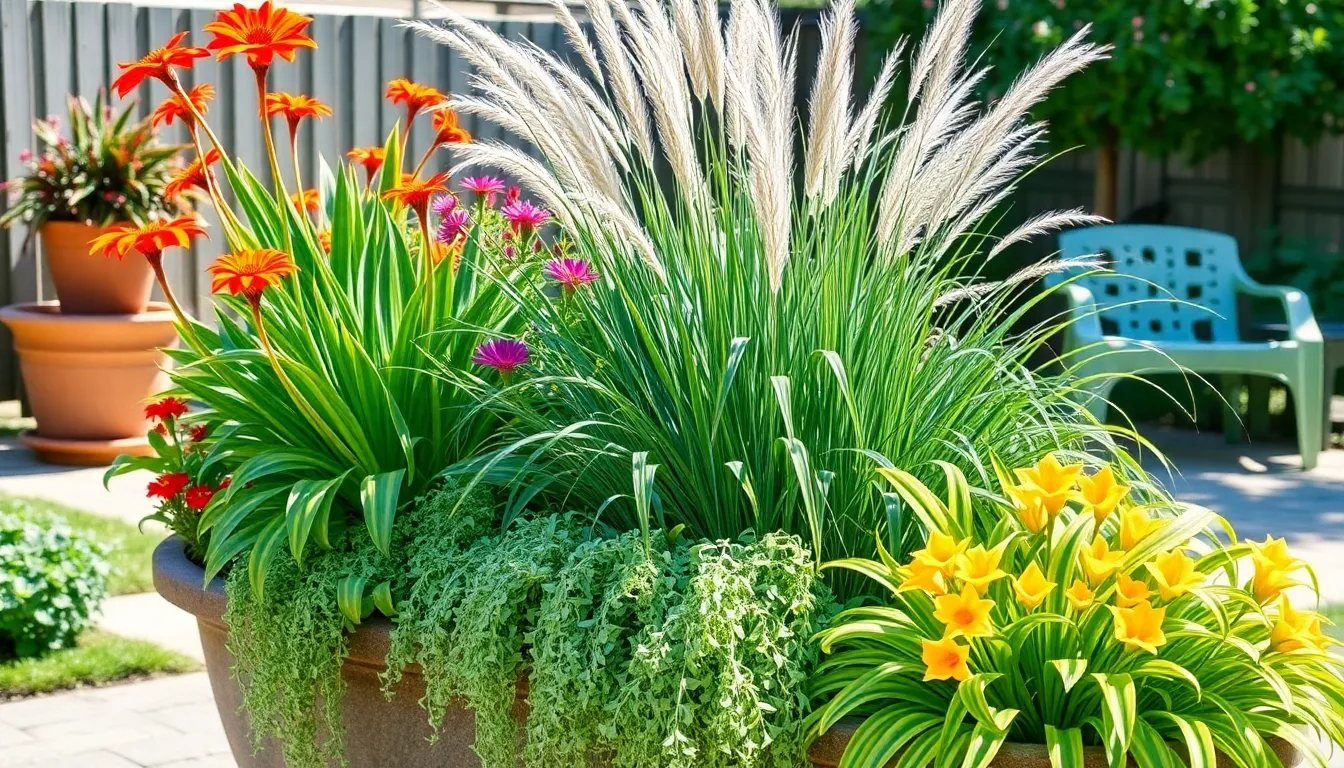
Container gardening success depends heavily on choosing plants that naturally adapt to pot life. We’ll explore three key strategies for selecting plants that’ll flourish in our container landscapes.
Pick Climate-Appropriate Species
Selecting plants that match our local climate conditions ensures healthier growth and reduces maintenance demands. Sun-loving varieties like foxtail ferns and purple fountain grass excel in hotter, sunnier locations where they can soak up abundant light throughout the day. Cooler or more humid regions call for different plant choices that tolerate these exact environmental conditions without stress.
We can achieve stunning results by matching our plant selections to our area’s temperature ranges, humidity levels, and seasonal patterns. This approach creates more resilient container gardens that require less intervention and watering. Climate-appropriate species also tend to have longer growing seasons and better resistance to local pests and diseases.
Mix Textures and Heights for Visual Interest
Creating ever-changing container arrangements requires thoughtful combinations of plants with varying forms and textures. Bold, tall specimens like cannas or banana trees provide dramatic vertical elements that anchor our designs and create focal points. Pairing these statement plants with finer-textured ornamental grasses such as fountain grass (Pennisetum) and switchgrasses adds movement and softness to the composition.
Trailing plants like Silver Falls Dichondra and trailing verbena spill gracefully over container edges, softening hard lines and creating natural flow. We can layer these different plant forms to build depth and visual complexity that draws the eye through the entire arrangement. Combining broad leaves with narrow foliage, smooth textures with fuzzy ones, and upright growth habits with cascading forms creates the most captivating displays.
Consider Seasonal Blooming Patterns
Planning for continuous color throughout the growing season requires strategic plant selection with staggered blooming times. We can incorporate a mix of annuals, perennials, and shrubs that flower during different periods to maintain ongoing visual interest. Intenz Celosia provides late summer blooms when many other plants begin to fade, while Butterfly Bush and Magic Purple Aster extend the flowering period well into fall.
Successful container species like calibrochoa, sun coleus, gaillardia, and agastache offer extended blooming periods that overlap with other plants for seamless color transitions. Vegetables such as tomatoes, peppers, lettuce, and summer squash can also contribute to seasonal interest while providing fresh produce for our tables. This layered approach to bloom timing ensures our container gardens remain vibrant and captivating from spring through fall.
Create Stunning Focal Points with Large Statement Pots

Large statement pots transform ordinary outdoor spaces into captivating landscapes that command attention. We’ll explore how oversized planters serve as visual anchors while dramatic plant combinations and architectural elements elevate your container garden design.
Position Oversized Planters Strategically
Strategic placement of oversized pots creates immediate visual impact in key areas of your industry. We recommend positioning large planters near entryways where they frame doorways and welcome guests with symmetrical elegance. Identical statement pots placed on either side of pathways define boundaries while maintaining harmonious balance throughout your outdoor space.
Tiered arrangements add dimension and height to your container displays. Stacking pots or placing them on risers elevates smaller plants above ground level, creating layered compositions that capture attention from multiple viewing angles. We use this technique to ensure every plant receives proper visibility while building dramatic vertical interest.
Key locations for oversized planters include patio corners, pathway intersections, and areas where you want to punctuate transitions between different industry zones. Positioning these statement pieces strategically helps define outdoor rooms while drawing the eye to exact focal points you want to highlight.
Use Bold Plant Combinations for Drama
Contrasting textures create the most striking visual drama in large container arrangements. We combine tall architectural foliage like ornamental grasses with trailing vines and colorful flowering plants to generate ever-changing compositions that captivate viewers. Mixing fine textured plants with bold, broad leafed specimens adds depth and visual complexity to your potted displays.
Color coordination between plant foliage and blooms enhances the overall impact of your container gardens. We use color echoes by matching coleus foliage with similarly hued dahlias or combining purple flowering plants with burgundy leafed varieties. This technique produces unified, bold container designs that feel intentional and professionally crafted.
Height variations within single large pots create natural layering that mimics traditional garden beds. We place tall specimens like elephant ears or cannas in the center, medium height plants like begonias around the middle, and trailing varieties like sweet potato vine along the edges to cascade over pot rims.
Incorporate Architectural Elements
Geometric shapes bring structure and order to container plantings while complementing the organic nature of plants. We shape shrubs like boxwood into squares, circles, or triangles within large pots to create formal focal points that balance wild, flowing plant combinations. These structured elements provide visual stability in otherwise ever-changing arrangements.
Staging and risers allow for creative layering while improving plant visibility in grouped container displays. We use hidden supports to elevate certain pots, creating stepped arrangements that showcase each plant’s unique characteristics. This technique prevents taller plants from overshadowing shorter specimens while adding architectural interest to the overall composition.
Repetitive patterns created through consistent pot placement or plant selection tie disparate elements together into cohesive industry designs. We repeat exact plant varieties or container styles at regular intervals throughout the space to create rhythm and visual flow that guides visitors through your outdoor areas.
Design Layered Arrangements for Depth and Dimension
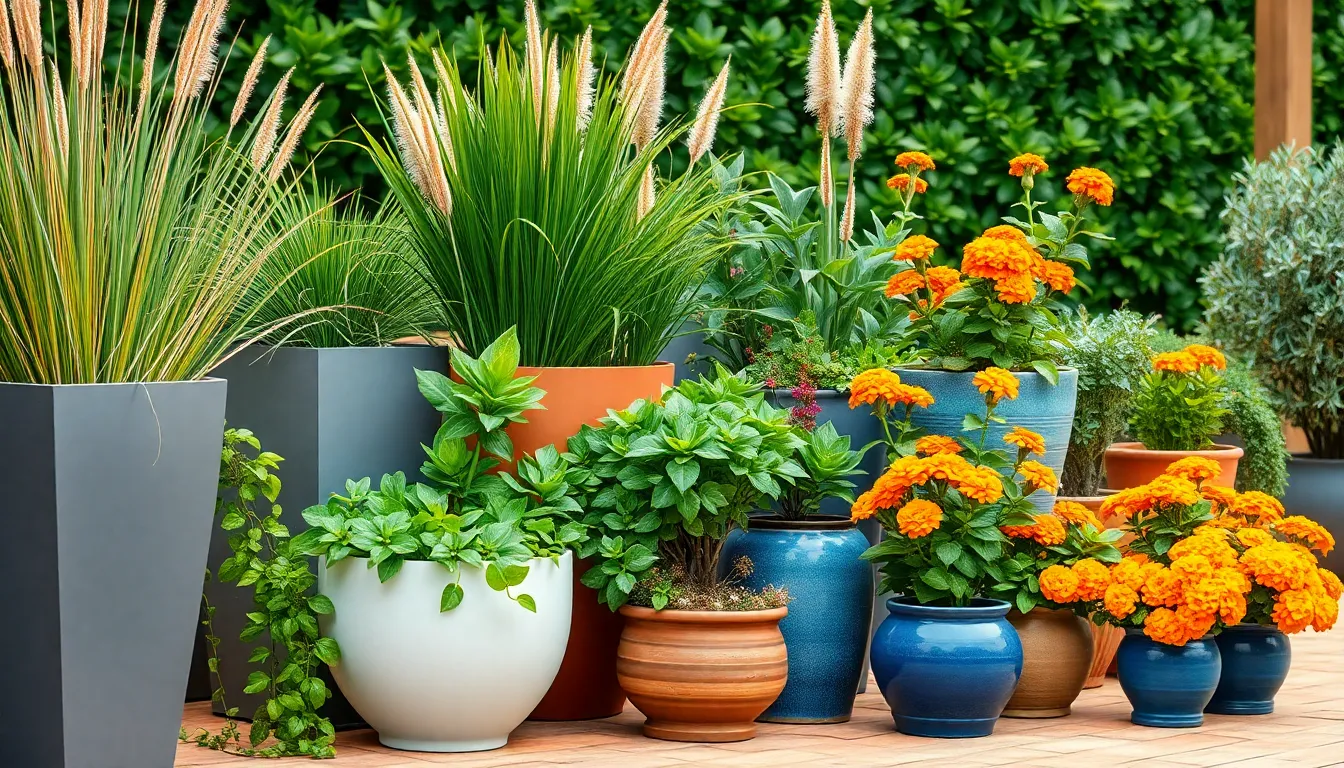
Layering transforms flat outdoor spaces into ever-changing, multi-dimensional landscapes that capture attention and create visual intrigue. We achieve this depth by arranging containers at different heights and levels using natural elevations, stands, or stacked configurations.
Vary Container Heights and Sizes
Mixing container dimensions creates visual contrast and natural flow in our potted plant displays. Tall, slender pots work beautifully with upright plants like ornamental grasses or small trees, while low, wide containers showcase ground covers and trailing varieties like ivy or petunias. We recommend combining these different proportions to break monotony and establish pleasing visual rhythms.
Elevating smaller plants on risers or overturned pots helps unify groups with mixed plant heights. This technique brings shorter specimens to eye level and creates seamless transitions between different container sizes. Plant stands, decorative blocks, or even sturdy overturned pots serve as effective elevation tools that maintain stability while adding architectural interest.
Group Odd Numbers of Pots Together
Clustering containers in odd numbers creates naturally balanced arrangements that feel more captivating than even-numbered groups. Three or five pots grouped together follow classic design principles that our eyes find inherently pleasing. These odd-numbered clusters appear more organic and less formal than symmetrical pairs or quartets.
Varying pot shapes and sizes within each cluster maintains visual cohesion while avoiding rigid uniformity. We might combine a tall cylindrical planter with two shorter, wider bowls, or arrange three different-sized spherical containers. This variation keeps the grouping interesting while the odd number maintains overall balance and harmony.
Create Color Harmonies and Contrasts
Color coordination between containers and plants intensifies the vibrancy of our landscaping displays. We can paint terracotta pots to match flower colors, creating monochromatic schemes that feel sophisticated and intentional. Analogous color palettes using neighboring hues on the color wheel produce harmonious, calming effects.
Complementary color combinations generate striking visual drama that draws immediate attention. Orange marigolds in deep blue containers create vibrant contrasts, while purple petunias in yellow pots establish bold focal points. We enhance these effects by selecting plants with foliage that echoes or contrasts with container colors, building layered color relationships throughout our designs.
Establish Defined Pathways and Borders
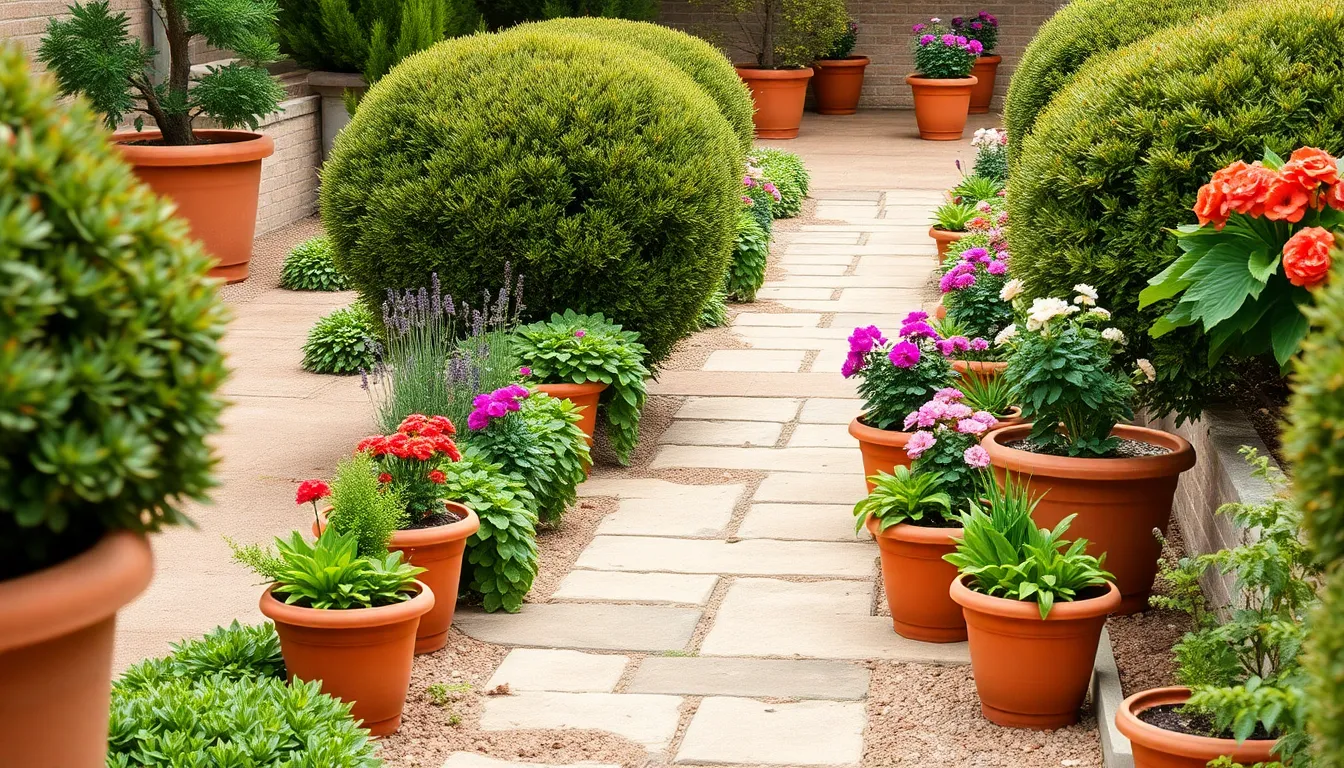
We’ll transform our outdoor spaces into organized, visually appealing landscapes by strategically positioning potted plants to define walking routes and garden boundaries. Arranging containers in balanced layouts creates clear navigation while adding natural beauty to our pathways.
Line Walkways with Matching Containers
Matching containers provide the uniformity we need to create elegant, cohesive walkways throughout our outdoor spaces. Terra cotta pots and wicker lined baskets work exceptionally well when we maintain consistent materials and colors along our garden paths. We can enhance visual appeal by implementing the filler, spiller, and thriller method inside each container, where tall central plants anchor the arrangement while trailing and bushy plants add depth and movement.
Consistency in our pot selection paired with diverse, complementary plant combinations transforms ordinary walkways into living corridors. Placing these matching containers at regular intervals guides foot traffic naturally while creating rhythm and visual flow. Our walkways become more than functional paths when we balance uniformity in containers with variety in plant textures and heights.
Create Natural Boundaries Between Garden Zones
Larger pots containing shrubs or small evergreen trees serve as flexible, movable natural boundaries that effectively separate different functional areas in our gardens. We can rearrange these container boundaries as our landscaping needs change, making them ideal for evolving outdoor spaces. Positioning containers in repetitive, symmetrical patterns reinforces the sense of division while maintaining visual cohesion between zones.
Strategic placement of these boundary containers helps us define outdoor rooms without permanent structures. Evergreen plants in substantial pots provide year round separation that remains attractive through all seasons. Our garden zones feel distinctly organized when we use these natural boundaries to create purposeful transitions between spaces.
Use Repetitive Plantings for Cohesion
Repetition in container shape, color, or plant type creates the unified garden industry we desire through consistent design elements. Grouping pots with the same color palette builds harmony, while trimming plants into geometric shapes like circles or squares establishes rhythm and balance throughout our outdoor space. We achieve particularly successful results in formal gardens where this harmonious approach enhances the overall visual impact.
Repetitive plantings arranged in lines or patterns work especially well in larger outdoor areas where we need strong visual continuity. Varying heights within our repetitive arrangements prevents monotony while maintaining the cohesive look we’re seeking. Our industry achieves both aesthetic beauty and functional design cohesion when we combine these repetitive elements with our pathway and boundary strategies.
Maximize Small Spaces with Vertical Container Gardens
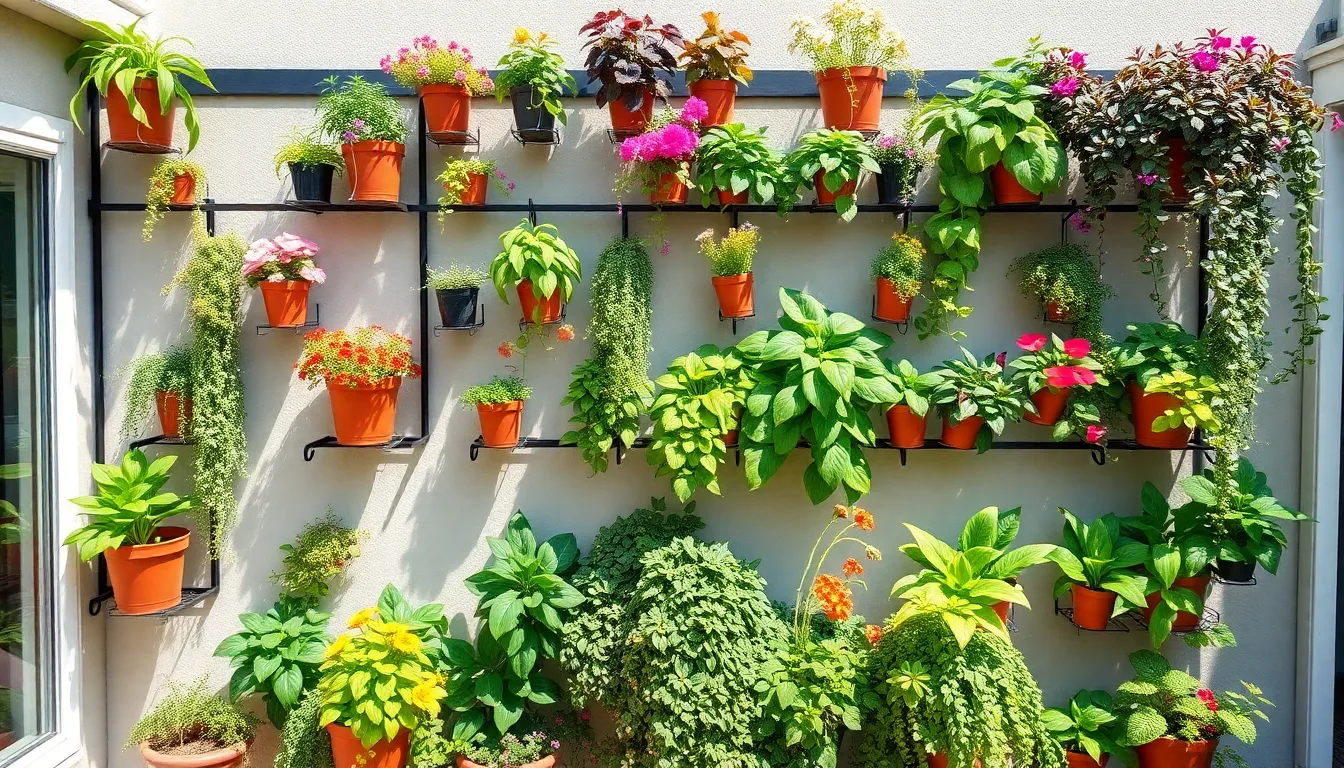
Vertical gardening transforms limited outdoor areas into lush growing spaces by utilizing upward rather than outward expansion. We can conserve valuable floor space while creating stunning plant displays that work perfectly for small patios, balconies, and compact yards.
Use Walls and Fences for Growing Space
Walls and fences become valuable real estate for our container gardens when we mount planters directly onto these surfaces. We can install wall-mounted brackets, pocket planters, or hanging systems that transform bare vertical spaces into living green walls. These installations not only expand our growing area but also enhance privacy and create beautiful backdrops for our outdoor spaces.
Consider the lighting conditions on each wall surface before selecting plants. We should choose sun-loving varieties for south-facing walls that receive direct sunlight throughout the day. Shade-tolerant plants work best on north-facing surfaces or areas blocked by buildings and structures.
Quality mounting hardware ensures our wall-mounted containers stay secure during wind and weather. We recommend using heavy-duty brackets rated for the combined weight of containers, soil, and plants when fully watered.
Stack Containers for Multi-Level Displays
Stacking containers creates dramatic tiered effects that maximize planting area without requiring additional ground space. We place larger, heavier pots at the bottom level for stability and stack smaller containers on stands, benches, or specially designed tiered plant stands above them.
This method allows us to group plants with varying heights, colors, and textures into ever-changing multi-level displays. We can combine trailing plants that cascade from upper containers with upright specimens in lower pots to create natural-looking arrangements.
Stability becomes crucial when stacking multiple containers. We ensure each level has a solid base and avoid creating top-heavy arrangements that might topple during storms or strong winds.
Hang Planters at Different Heights
Hanging planters suspended at varying heights add dimension and visual interest while maximizing our use of vertical space. We can install hooks at different elevations on pergolas, tree branches, or overhead structures to create layered garden effects.
This technique works especially well for trailing plants and cascading flowers that spill beautifully from elevated containers. We mix different hanging heights to improve sunlight access for each plant and create depth in our garden design.
Rotating mechanisms on hanging planters help ensure even sun exposure for all sides of our plants. We should also consider the mature size and weight of plants when selecting hanging containers and support systems.
Incorporate Seasonal Flexibility in Your Design
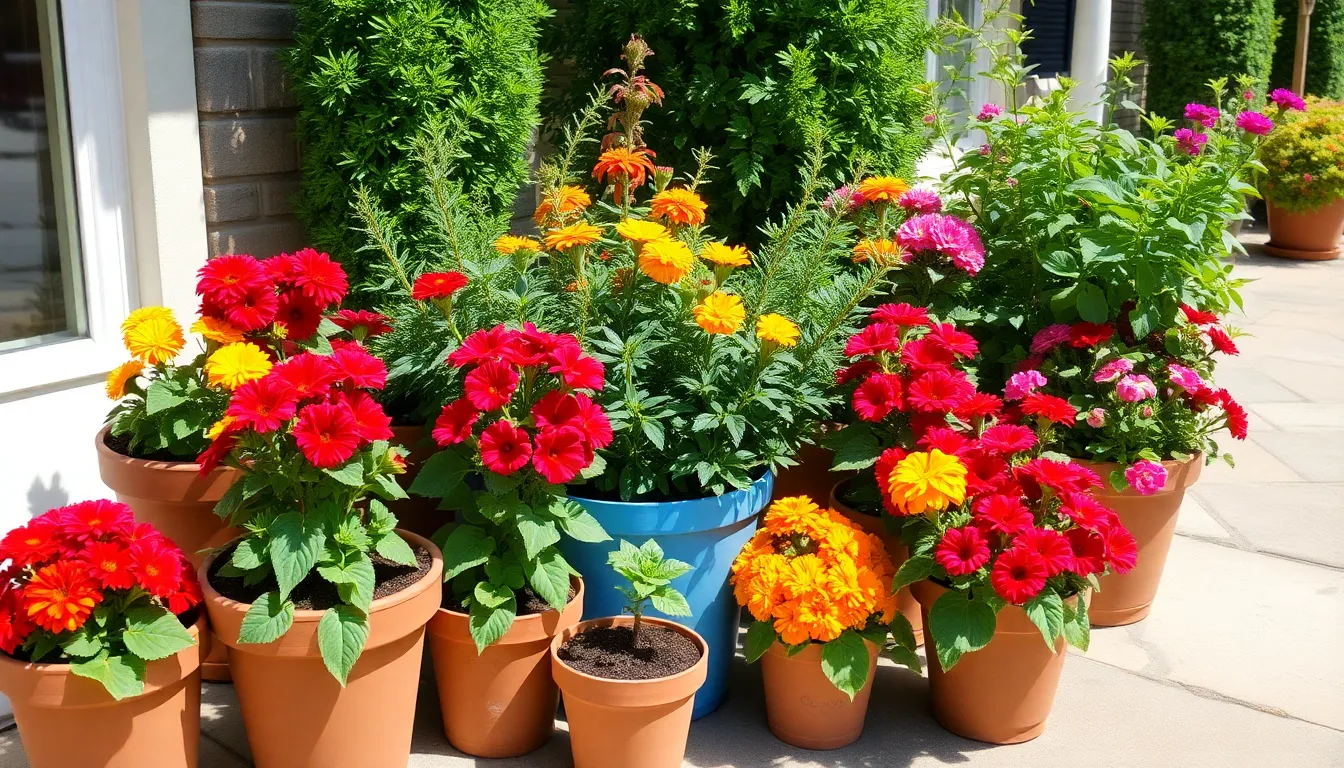
Designing container gardens with seasonal adaptability ensures our outdoor spaces remain vibrant and captivating throughout the year. We achieve lasting appeal by combining structural elements with flexible planting strategies that can evolve with changing seasons.
Plan for Easy Plant Swapping
Planning ahead for seasonal transitions makes maintaining ever-changing container displays effortless and cost effective. We choose lightweight containers like fiberglass pots that allow us to move and replant easily when seasons change. Having compatible plants ready to swap keeps our gardens fresh year round—summer annuals can be quickly replaced with cool season varieties like pansies or ornamental kale for fall and winter interest.
Seasonal Swapping Schedule:
| Season | Remove | Add |
|---|---|---|
| Spring to Summer | Cool season annuals | Heat tolerant flowers like petunias |
| Summer to Fall | Heat stressed plants | Mums, ornamental cabbage |
| Fall to Winter | Tender annuals | Evergreen branches, winter berries |
| Winter to Spring | Dormant plants | Early blooming bulbs, pansies |
Strategic container placement near storage areas or covered spaces makes seasonal swapping more convenient and protects plants during transitions.
Create Year-Round Color Schemes
Creating cohesive color palettes that work across multiple seasons provides visual continuity in our container gardens. We establish foundation colors using evergreens and plants with interesting foliage, then layer seasonal flowers that complement this base palette. Snapdragons, dianthus, and veronicas deliver vibrant summer colors while pairing beautifully with dusty miller or sedum that maintain visual interest during cooler months.
Color Combination Examples:
| Base Plants | Summer Additions | Fall/Winter Additions |
|---|---|---|
| Dusty miller, sedum | Purple petunias, yellow marigolds | Burgundy mums, orange pansies |
| Evergreen conifers | White impatiens, pink begonias | Red winterberry, silver branches |
| Trailing ivy | Blue lobelia, coral geraniums | Purple ornamental kale, white cyclamen |
Trailing plants like ivy or cascading sedum add dimension by spilling over pot edges and create softness that balances upright plant forms throughout all seasons.
Store Containers During Harsh Weather
Storing containers properly during extreme weather conditions extends both pot and plant lifespan while protecting our investment. We move portable containers to sheltered areas like covered patios, garages, or basements when freezing temperatures or intense summer heat threaten plant health. Containers made from durable materials like fiberglass or concrete withstand outdoor conditions better than terracotta or ceramic, but all benefit from seasonal protection.
Weather Protection Guidelines:
| Weather Condition | Storage Location | Additional Protection |
|---|---|---|
| Freezing temperatures | Unheated garage, basement | Wrap pots in bubble wrap |
| Extreme summer heat | Covered patio, shade structure | Group containers for humidity |
| Heavy winter snow | Indoor storage area | Drain excess water first |
| Strong winds | Against protected walls | Secure with weights or stakes |
Emptying saucers and ensuring proper drainage before storage prevents freeze damage and root rot that can destroy both containers and plants during harsh weather periods.
Maintain Your Potted Landscape for Long-Term Success
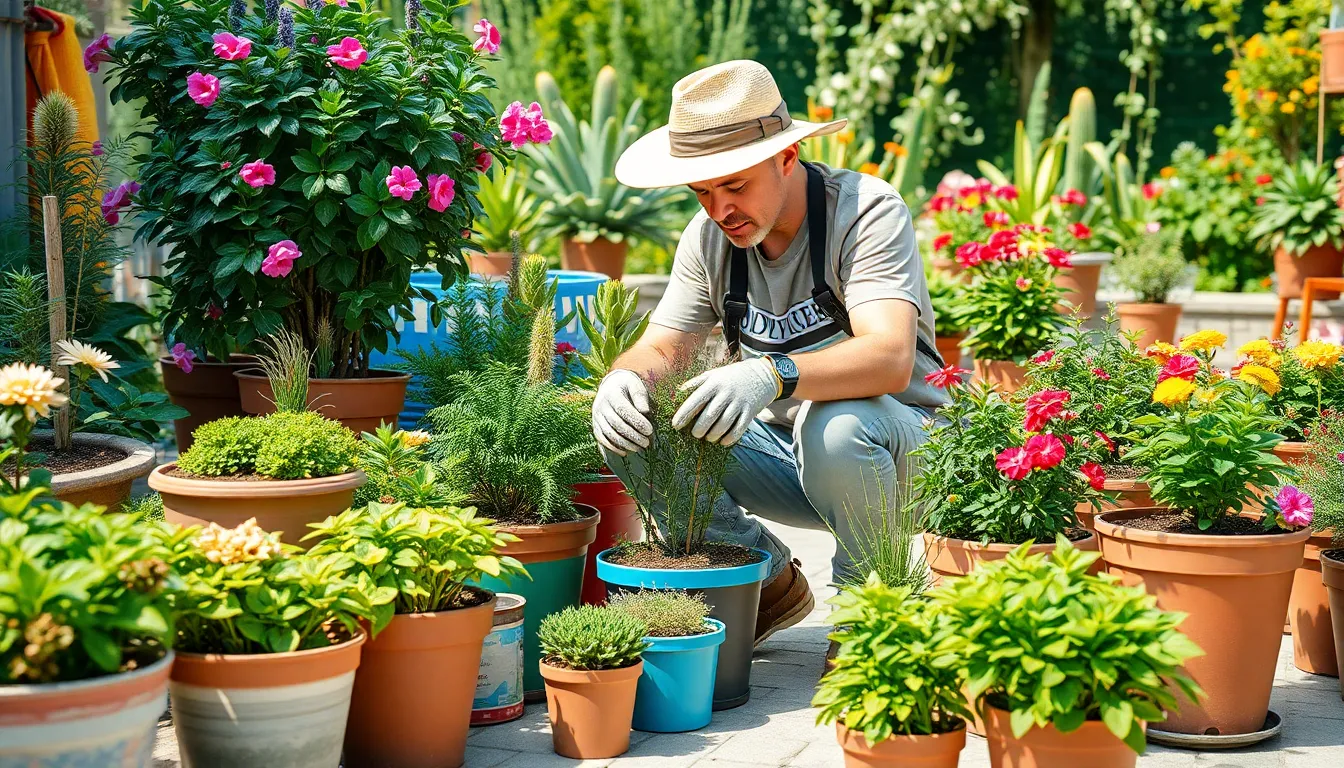
Consistent care transforms your beautiful container arrangements into thriving, sustainable displays that enhance your outdoor space year after year. We’ll guide you through essential maintenance practices that keep your potted industry healthy and vibrant.
Establish Regular Watering Schedules
Check soil moisture daily by inserting your finger 1-2 inches into the potting mix to gauge water needs. Potted plants require more frequent watering than in-ground plants due to limited soil volume and faster drying rates through container walls.
Water deeply and thoroughly until you see drainage from the bottom holes, ensuring the entire root system receives adequate moisture. Morning watering proves most effective as it allows plants to absorb water before afternoon heat increases evaporation rates.
Adjust frequency based on weather conditions since hot, windy days accelerate soil drying while cool, humid periods reduce water needs. Large containers retain moisture longer than small pots, so tailor your watering schedule to pot size and plant species requirements.
Group containers with similar water needs together to streamline your maintenance routine and prevent over or under watering different plant types. Drought tolerant succulents need less frequent watering than moisture loving ferns or annual flowers.
Carry out Proper Fertilization Routines
Feed container plants every 2-4 weeks during the active growing season since nutrients deplete quickly from frequent watering and limited soil volume. Balanced liquid fertilizers work best for most container gardens, providing immediate nutrient availability to plant roots.
Apply slow release granular fertilizer at the beginning of each growing season to provide steady nutrition over several months. This approach reduces maintenance while ensuring consistent plant health and robust development throughout the season.
Monitor plant appearance for signs of nutrient deficiency such as yellowing leaves, poor flowering, or stunted growth that indicate fertilization adjustments are needed. Different plants require exact nutrient ratios, so use specialized fertilizers for acid loving plants, flowering annuals, or vegetables when appropriate.
Reduce fertilization frequency during fall and winter months when plant growth slows and nutrient requirements decrease significantly.
Monitor for Pests and Diseases
Inspect plants weekly during your watering routine to catch pest infestations and disease symptoms early when treatment is most effective. Look for discolored leaves, unusual spots, webbing, or visible insects on both leaf surfaces and stems.
Remove affected plant material immediately to prevent spread of diseases or pest populations to healthy plants in your container display. Proper sanitation includes cleaning pruning tools between plants and disposing of infected debris away from your garden area.
Treat problems promptly with appropriate organic or chemical answers based on the exact pest or disease identified. Horticultural oils, insecticidal soaps, and neem oil provide effective treatment for many common container plant pests like aphids, spider mites, and scale insects.
Improve air circulation around containers by spacing them appropriately and avoiding overcrowding that creates humid conditions favorable to fungal diseases. Proper plant spacing also makes inspection and treatment easier while maintaining the aesthetic appeal of your arrangement.
Conclusion
Container gardening offers us endless possibilities to transform any outdoor space into a stunning industry. We’ve explored how the right combination of containers plants and design techniques can create impressive visual displays that rival traditional gardens.
The beauty of potted plant landscaping lies in its adaptability. We can experiment with different arrangements adjust for seasonal changes and maintain our gardens regardless of space limitations or soil conditions.
Whether we’re working with small patios or expansive decks the principles remain the same: thoughtful plant selection proper container choices and strategic placement create maximum impact. With consistent care and creative vision our container gardens will flourish year-round.
Now it’s time to put these ideas into practice and watch our outdoor spaces bloom with personality and style.
Frequently Asked Questions
What are the main benefits of landscaping with potted plants?
Container gardening offers flexibility and portability, making it perfect for small patios, balconies, or rental properties. You can experiment with different layouts, create seasonal displays, and move plants as needed. It eliminates the need for perfect soil conditions and allows you to create stunning landscapes without extensive land requirements.
How do I choose the right containers for my potted plant landscape?
Select containers based on size and scale – use larger pots for specimen plants, medium containers for groupings, and small accent pots for finishing touches. Choose weather-resistant materials like fiberglass, concrete, or resin for durability. Ensure proper drainage with holes, layers, and elevated positioning to prevent root rot.
What types of plants work best in container gardens?
Choose climate-appropriate species for healthier growth and reduced maintenance. Mix textures and heights by combining bold, tall plants with fine-textured varieties and trailing plants. Include a variety of annuals, perennials, and vegetables that bloom at different times to ensure continuous color throughout the growing season.
How can I maximize small spaces with container gardening?
Utilize vertical space by mounting planters on walls and fences using brackets and hanging systems. Stack containers for multi-level displays and hang planters at different heights. This creates dramatic tiered effects without requiring additional ground space, making it perfect for balconies and small patios.
How do I maintain seasonal interest in my container garden?
Plan for easy plant swapping to maintain vibrant displays year-round. Create a seasonal schedule and cohesive color schemes that work across multiple seasons. Store containers properly during harsh weather to protect plants and extend container lifespan. Regular rotation keeps displays fresh and exciting.
What maintenance is required for potted landscapes?
Establish regular watering schedules since container plants dry out faster than ground plants. Follow proper fertilization routines as nutrients wash away more quickly in pots. Monitor regularly for pests and diseases, and ensure consistent care including pruning, deadheading, and seasonal plant replacement for long-term success.
How do I create visual impact with large statement pots?
Place oversized planters strategically near entryways and pathways to create immediate visual impact and define outdoor rooms. Use bold plant combinations with contrasting textures and coordinated colors. Incorporate architectural elements like geometric shapes and tiered arrangements to add structure and enhance drama.
What design techniques create depth in container arrangements?
Vary container heights and sizes to establish visual contrast and flow. Group pots in odd numbers for a more organic, balanced look while varying shapes within clusters. Elevate smaller plants to eye level and use color harmonies and contrasts between containers and plants to create striking visual effects.

